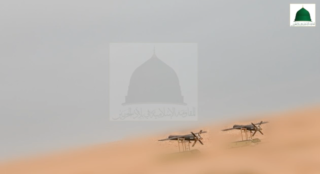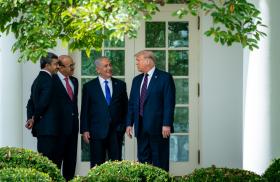
Anti-Israel Attacks by Iraq-Based Group with Inferred Saudi Membership

The Islamic Resistance in the Land of the Two Mosques has claimed six attacks on Israel, probably launching them from Iraq using Kataib Hezbollah and/or Houthi drone teams.
In recent weeks, a new facade group has claimed responsibility for drone attacks against Israel. The group is called al-Muqawama al-Islamiya fi Bilad al-Haramain (MIBH, Islamic Resistance in the Land of the Two Mosques), suggesting its affiliation with pro-Iran militants from Saudi Arabia. Saudi Arabia is sometimes referred to as the 'Land of the Two Holy Mosques,' a title that honors the two holiest mosques in Islam: al-Masjid al-Haram in Mecca and al-Masjid an-Nabawi in Medina. It is also occasionally called the 'Land of the Two Mosques’.
MIBH claimed responsibility for its first strike on October 25, claiming that it was launched from Saudi territory. Their statement reads: “With pride and honor, the Islamic Resistance in the Land of the Two Mosques announces the launch of its first jihadist operation, targeting a vital site in occupied Palestine... via drone. This operation, carried out by the Islamic Resistance from the Land of the Two Mosques, is a manifestation of the living will of the people of the Arabian Peninsula…” to fight Israel (Figure 1).
The group has so far claimed responsibility for six operations:
- October 25, drone attack on a vital site in Israel (unspecified location);
- October 31, drone attack on a target in Jordan Valley;
- November 9, drone attack on a target in Jordan Valley;
- November 10, drone attack on a target in Jordan Valley;
- November 12, drone attack on a target in Eilat; and
- November 17, drone attack on a target in Jaffa (Tel Aviv).
The group has also published three short videos of these purported attacks—two recorded during the daytime and one at night. As usual, a significant portion of the scenes in these videos is blurred to prevent geolocation. However, the terrain visible in these videos appears to differ from the locations typically shown in videos published by the Islamic Resistance in Iraq (IRI) for drone launches, which most likely occur in Syria. The landscape seen in these videos is pristine dune desert, perhaps intended to look like northern Saudi Arabia, indicating the possibility that these groups crossed the border to launch the attacks from Saudi territory or at least want to give that impression (Figure 2).
Despite its name, all evidence suggests that this is a facade group established by the Iraqi muqawama. The language used in the statements closely mirrors that of IRI. Additionally, the style of the videos showcasing the purported attacks further indicates that this is a front for the Iraqi muqawama. While the Iraqi militias are rumoured have a limited number of Saudi and other Gulf Arab guest fighters and trainees, any Saudi citizens involved in these attacks are probably led by Iraqi militants. This recalls the April 27, 2024 drone attack on Israel claimed in the name of Bahraini group Saraya al-Ashtar that also probably was an Iraqi-orchestrated affair.
The emergence of an apparent Saudi wing of the Islamic Resistance in Iraq reminds us of the January 2024 statements by Kataib Hezbollah, in which support was pledged towards future operations in Saudi Arabia. On January 9, the military spokesman of Kataib Hezbollah (KH), Jafar al-Husseini, noted: “We also have the resistance in Bahrain and Hejaz [Saudi Arabia]. Even though their presence is not clear now, it will be more visible in the coming years and the coming confrontations.” Using its facade group Alwiyat al-Waad al-Haq (AWH), KH remains Iran's main southward-facing proxy in Iraq, with responsibility for operations against the Gulf states.
We also draw attention to the recent boost in Houthi hosting of Saudi oppositionists in Sanaa. In addition to hosting Saudi Ismailis from Najran, which the Houthis consider to be Saudi-occupied Yemeni territory, the Houthis have also hosted and trained Saudi citizens from the Shia minority, particularly from Qatif. On 31 October, 2024, the Houthis announced the gathering of a “military council” of Saudi oppositionists in Sanaa. In early November, the Houthi-controlled Saba TV broadcast segments with oppositionists. These reflect the Houthis’ long-hoped-for position as a revolutionary vanguard amongst resistance axis groups, a consolidation of leadership within the Arabian Peninsula. When combined with KH and Houthi joint operations versus Israel – as evidenced by the killing of a senior Houthi drone specialist at a KH site in Jurf as-Sakr on June 30, 2024 – one can sense the growing encirclement of Saudi Arabia by these two Iranian partner forces.







